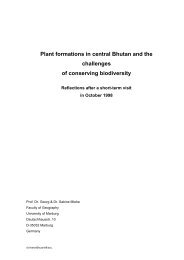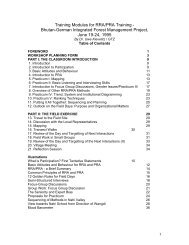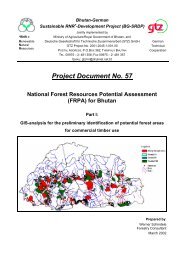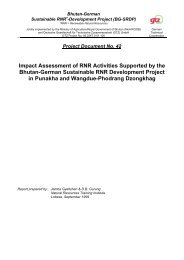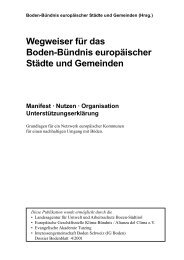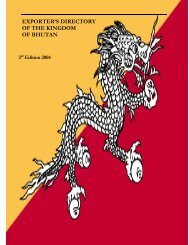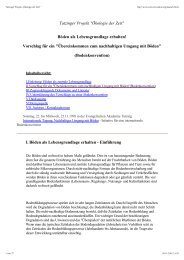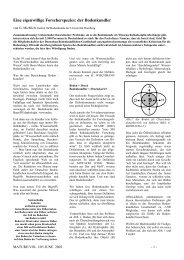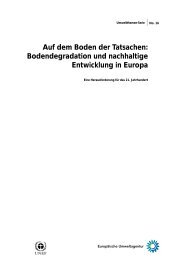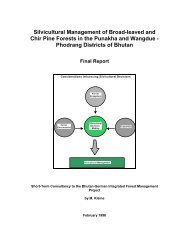GTZ Project Document No. 51 Report on Nahi Baseline Survey
GTZ Project Document No. 51 Report on Nahi Baseline Survey
GTZ Project Document No. 51 Report on Nahi Baseline Survey
You also want an ePaper? Increase the reach of your titles
YUMPU automatically turns print PDFs into web optimized ePapers that Google loves.
<strong>Nahi</strong> <strong>Baseline</strong> <strong>Survey</strong> April- May 2001Abstract<strong>Nahi</strong> geog under Wangdue Dznogkhag is the pilot project area of Bhutan GermanSustainable RNR Development <str<strong>on</strong>g>Project</str<strong>on</strong>g> (BG-SRDP). As such, in the past a series ofstudies have been c<strong>on</strong>ducted in the valley in collaborati<strong>on</strong> with other institutes andindividuals. In additi<strong>on</strong> the c<strong>on</strong>structi<strong>on</strong> of the 11.85 km new access road started in2000 represents a significant c<strong>on</strong>tributi<strong>on</strong> and an important landmark in the history ofthe valley’s overall infrastructure development. Therefore, the idea to developbaseline informati<strong>on</strong> <strong>on</strong> the geog inorder to m<strong>on</strong>itor short-term changes during the<str<strong>on</strong>g>Project</str<strong>on</strong>g> implementati<strong>on</strong> phase for future studies has obliged the <str<strong>on</strong>g>Project</str<strong>on</strong>g> to c<strong>on</strong>duct thisstudy.<strong>Nahi</strong> valley has almost 90% of its total area under forest. The valley is home to about622 people (95 households). Agriculture is the main occupati<strong>on</strong> of the peopleproviding direct employment to about 60% of the working populati<strong>on</strong>. In most caseswhatever is produced is c<strong>on</strong>sumed or retained <strong>on</strong> the farm for producti<strong>on</strong> purposes.The terraced irrigated wetland dominate the landuse pattern in the valley followed bysome dryland and tsheri. The paddy is the dominant summer crop in the wetlandfollowed by wheat and barley during winter and early spring. The dry land cropsinclude maize, wheat, barley and buckwheat.The four main villages of the geog are Esawom, Hebisa, Nabisa and Esagom that arescattered over a large area. Most farmers do not have enough land (especially paddyland), landholdings range from households with no or little land to as high as 14 acres.As such, the wetland sharecropping is very comm<strong>on</strong> approximately accounting for23% of the total wetland in the valley. The geog, though small, shows a high degreeof social differentiati<strong>on</strong> especially with respect to wealth where majority require someseas<strong>on</strong>al food arrangements.Crop damages by wild animals, inadequate water for irrigati<strong>on</strong>, and labour shortageduring the peak seas<strong>on</strong> represent the three major problems in crop producti<strong>on</strong>.Although <strong>on</strong> an average each household has about 3.3 pers<strong>on</strong>s available <strong>on</strong> the farmirrespective of their age, <strong>on</strong>ly 2.2 pers<strong>on</strong>s are within the most active age group 16-49.About 87% of the total farm households practice labour exchange with neighboursand relatives.Crops are the most important income source for the majority of the households with ascore of 276 points, followed by vegetables (108), family c<strong>on</strong>tributi<strong>on</strong> (88), livestock(72) and forest products (69). The forest and livestock are important comp<strong>on</strong>ents ofthe valley’s farming system both as a source of income as well as inputs forproducti<strong>on</strong>.Household seas<strong>on</strong>al food shortages are generally met with some arrangement throughrelatives and neighbours or by purchasing from the market. For example, <strong>on</strong>ly 65% ofthe total resp<strong>on</strong>dents have sufficient rice while 35% need seas<strong>on</strong>al arrangements (22%meet the deficiency from market and 13% from neighbours and relatives).iii



